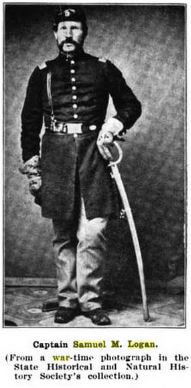
Little is known about his childhood. Military records suggest he was born on December 18, 1821 in Ohio, who the names of his parents and whether he had any siblings is unknown.
Samuel M. Logan was a Mexican American War veteran who was working as a blacksmith in Denver when the Civil War broke out. He didn’t waste any time in showing on which side his sympathies lay with a grand gesture.
On April 24, 1861, just days after the bombardment of Fort Sumter, the southern sympathizers who owned Wallingford and Murphey’s Mercantile on Larimer Street in downtown Denver raised the Confederate stars and bars on the pole atop their building. The flag attracted an angry mob of pro-Union sympathizers who threw rocks at the store and demanded that the flag come down.
 The Worst Enemy Illustration by Ian Bristow
The Worst Enemy Illustration by Ian Bristow Whichever is the case, Logan’s stunt made him popular enough that he was able to recruit a company of men to follow him into the volunteer army that William Gilpin, the newly appointed governor of the territory, was raising. In those days, whoever brought in the required number of men was given the commission to lead them. Samuel M. Logan, blacksmith and climber of roofs became Captain Samuel M. Logan of Company B of the Colorado Volunteers.
Logan’s reputation for quick and dramatic action led him to receive some orders that made for exciting press releases. In late August, his Company was ordered to clean out the Criterion, a saloon that was a notorious gathering place for secessionists. Logan and his men stormed in with bayonets fixed. They confiscated a large pile of weapons and ammunition and became the darling heroes of Denver.
However, the same qualities that made him a man of action didn’t make him a beloved leader. By September, Company B had delivered a petition to Governor Gilpin requesting that he remove Captain Logan, “whose overbearance and tyranny have become untolerable.” The Governor chose to ignore this petition.

From then on, Logan’s rise through the military was tied to that of John Chivington’s. Both were men of fiery and decisive action who held a “take no quarter” attitude, especially when it came to treatment of American Natives. By spring of 1864, Logan had been promoted to Lieutenant Colonel, bypassing other officers who argued for more leniency in dealings with the Plains Tribes. With Chivington, Logan participated in the infamous Sand Creek Massacre in November 1864. Both men managed to avoid prosecution for their part in the massacre because both mustered out before charges could be filed, but their implication in Sand Creek would permanently destroy their hopes for a future in politics.

Logan died in 1888, at age 61. He was buried in Riverside Cemetery in Denver. His wife, Mary, and son Samuel are buried with him.


